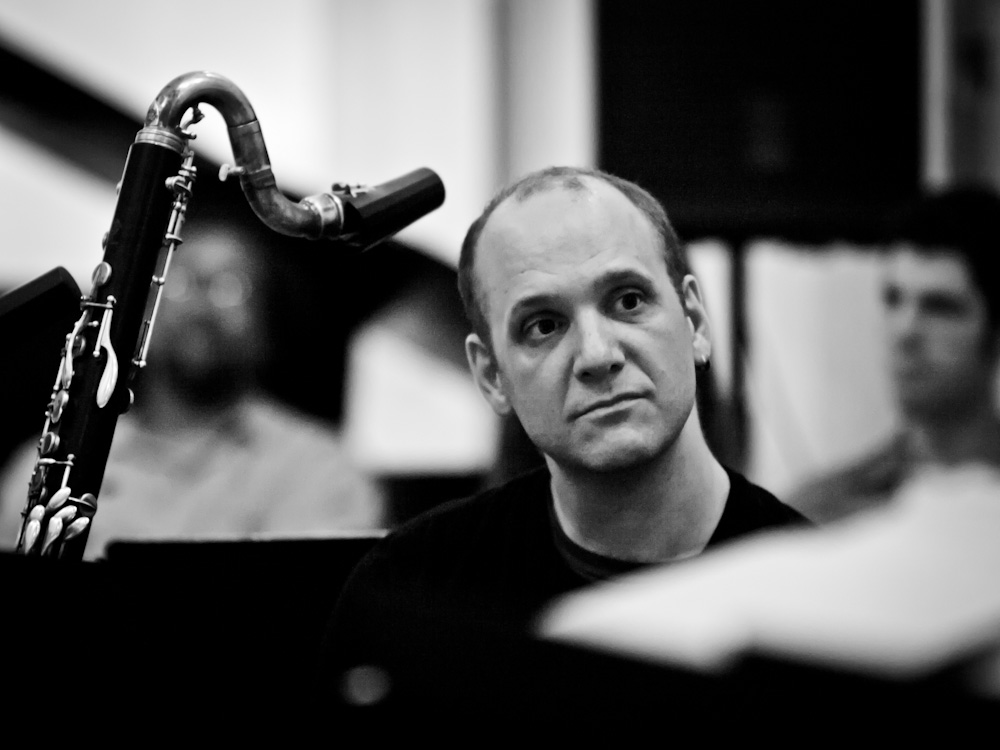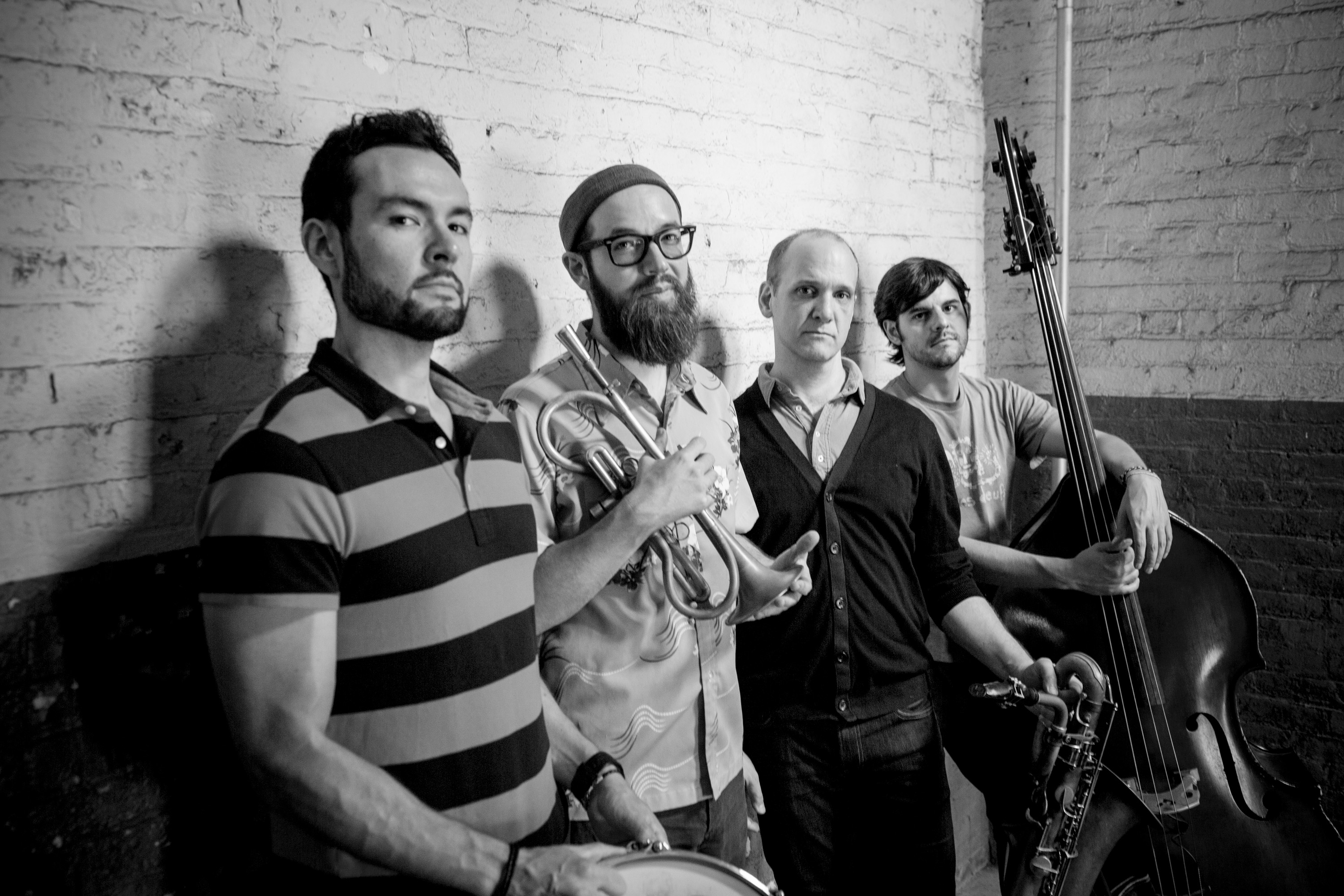Josh Sinton is an intrepid reeds player based in Brooklyn who leads the band Ideal Bread, among other groups. As one of the most active members of the Douglass Street Music Collective, he is well-known for his leading role within the musicians’ community, but has not been given the credit he deserves by the general public. Sinton possesses an uncompromising aesthetic that delves deeply into the sounds he explores, all the while orchestrating his music with great precision and attention to detail. His work with baritone saxophone and bass clarinet has pushed the boundaries of both instruments in a wide variety of musical contexts.
He founded Ideal Bread in 2006 with the explicit intention of playing and re-conceiving the music of Steve Lacy, Sinton’s former mentor when the latter studied at the New England Conservatory. Cornetist Kirk Knuffke and drummer Tomas Fujiwara have been with the band since its inception. Adam Hopkins joined the band on bass in January 2013. Ideal Bread has previously released two albums, The Ideal Bread (KMB Jazz, 2008) and Transmit: vol 2. of the Music of Steve Lacy (Cuneiform, 2010). While both of these albums brought fresh perspectives to some of Lacy’s more well-known tunes, the band’s third record, Beating the Teens, to be released May 13, 2014, is its most daring to date. This latest project, draws material from the box set Scratching the 70s, a compilation of some of Lacy’s earliest compositions, including the records Lapis, The Owl, Roba, Dreams, and Scraps.
Beating the Teens Record Release Party!
- Ideal Bread plays at Douglass Street Music Collective, May 1, 2014, at 8 pm. $15 cover.
Interview with Josh Sinton, conducted via email, April 26-29, 2014
Cisco Bradley: Your new album, Beating the Teens, is due out May 13. What new aspect of Steve Lacy’s music did you choose to focus on for this album?
Josh Sinton: Hmmm, I’m not sure I think of it as a *new* aspect. I feel like I decided to go back to his very first recordings as a composer. So in a way, I went back to his laboratory years when he was still trying to figure out the precise kind of alchemy he would be practicing. There’s a lot of unfinished sounds, unfinished thoughts in the source material and that incorporeality gave us a lot more space to be ourselves.
I do know that for this album, I was attracted to Lacy’s obsessive voicing of two horns in half and whole steps. On our previous albums, Kirk and I spent a lot of time getting the best unison and octave sounds we possibly could, so it was a good challenge to turn that on its head and learn how to play everything in tightly voiced dissonances.
CB: How do you see this project growing out of the band’s previous two records?
In our previous albums i was content to have us reproduce the surface of Lacy’s music. The outward sounds as he more-or-less presented them. Initially I just enjoyed the severe discipline of this exercise and people seemed to respond to it, seemed to like it. But more and more, that approach (of rigorous surface duplication) seemed bizarre and outdated and really unnecessary in this time of infinite reproductions. In addition, Tomas, Kirk and I had developed a band sound that was being unnecessarily constrained by this approach. That is, sometimes it’s fine for us to play songs in a composition-improvisation-composition format (this was Lacy’s preference over 90% of the time), but I didn’t see a reason for us to keep playing music that way every time we played. That was an approach that worked really well for Lacy, but it wasn’t making sense for us 100% of the time.
So the challenge was this: how do I keep the band together, keep it growing and yet still conform to the self-imposed definition of being a repertory band? How could I make sure we would express our own unique circumstances but still claim that we were playing music written by Steve Lacy? Things had to change and stretch. So that’s what we’ve done.
CB: What have you done to adapt Lacy’s compositions to the baritone/cornet/bass/drums lineup? What challenges have you faced in doing that?
JS: In our first two records, I really did very little believe it or not. I think some folks thought I had done a lot to change the pieces simply because I wasn’t playing a soprano saxophone. There were occasions when the melody was dropped an octave, and once we played a bridge in minor 9ths instead of minor 2nds because I couldn’t play that high yet. But if you do side-by-side comparisons of those first 2 albums with their source material, they’re fairly faithful recreations. Kirk and I had to spend a lot of time working on our altissimo range to execute that (pulling together the material for the first record took over a year of regular practicing of those 8 tunes), but eventually we were able to get it together.
This new record is different. I changed almost every tune. Some a lot, some a little. The changes were really dictated by our personalities more than our technique. There were things I wrote that were well beyond our abilities (like “Ladies” or the bass part in “Lesson”), but I knew that we would hustle to make it sound right. My concern was to match the music to the player whereas in the past the player was trying to match themselves to the music.
CB: What is the deepest impact that studying with Steve Lacy had upon you as a musician? As an arranger and composer?
JS: Patience. But a different expression of patience in both those arenas. As a player, I learned that it really is o.k. to become bored, become frustrated by the material I’m working on. If I’m patient and just keep playing the material in more-or-less the same way, I’ll pass through the boredom and find myself in a unique position I otherwise would have never discovered.
As a planner (an arranger, a composer), I’ve learned that sometimes a simple geometry is all that’s needed. That if I just a hang a simple strand of melody alone and unadorned in the air, that’s enough. And these melodies can be predictable, can be full of repetitions, can be composed of very simple, very elemental shapes. All that’s needed is that my interest as a listener be sustained and buoyed.
CB: Do you feel a lot of pressure as a student of Lacy and as one who is actively involved in shaping his living legacy?
JS: No. Because this thought has never crossed my mind. I mean this thought of shaping a legacy. I’m not being modest when I say I’m not the foremost authority on the music, life or times of Steve Lacy. Look, I came to his music (in a serious way) in 2002. That’s only 12 years ago. 2 years after I met him, he died. There are people around who have been consistently devoted to his music for decades. I take breaks from his music to work on my own music. There are people who saw him perform live dozens of times. I saw him live maybe 1 dozen times. I am not the person who will give you the be-all and end-all on Steve Lacy or his music. I’m just a musician who really likes some of this stuff and finds it curious and fun and challenging to work on. The best one could say about my work with Ideal Bread is that it reveals something about me and my predilections rather than anything innate to Lacy’s songs (other than the fact that they’re distinctive). The work I’ve done is fairly mundane (albeit sustained) and something that just about anyone could do.
CB: Is it too early to ask what your next project for the group will be?
JS: Currently I haven’t planned anything for Ideal Bread. I’m writing some original music right now that’s been on the back-burner for a while (for saxophone quartet, for various trios for creative quartet). That’s going to receive all my attention for the foreseeable future. But if this album is well-received and it seems like it’s in the cards, I’m sure I can dream up another Ideal Bread album.
Selected Discography
- Ideal Bread – Transmit: vol. 2 of the Music of Steve Lacy (Cuneiform, 2010)
- Ideal Bread – The Ideal Bread (KMB Jazz, 2008)



1 comment
Join the conversationJosh Sinton Interview | Avant Music News - May 2, 2014
[…] From Jazz Right Now: […]
Comments are closed.